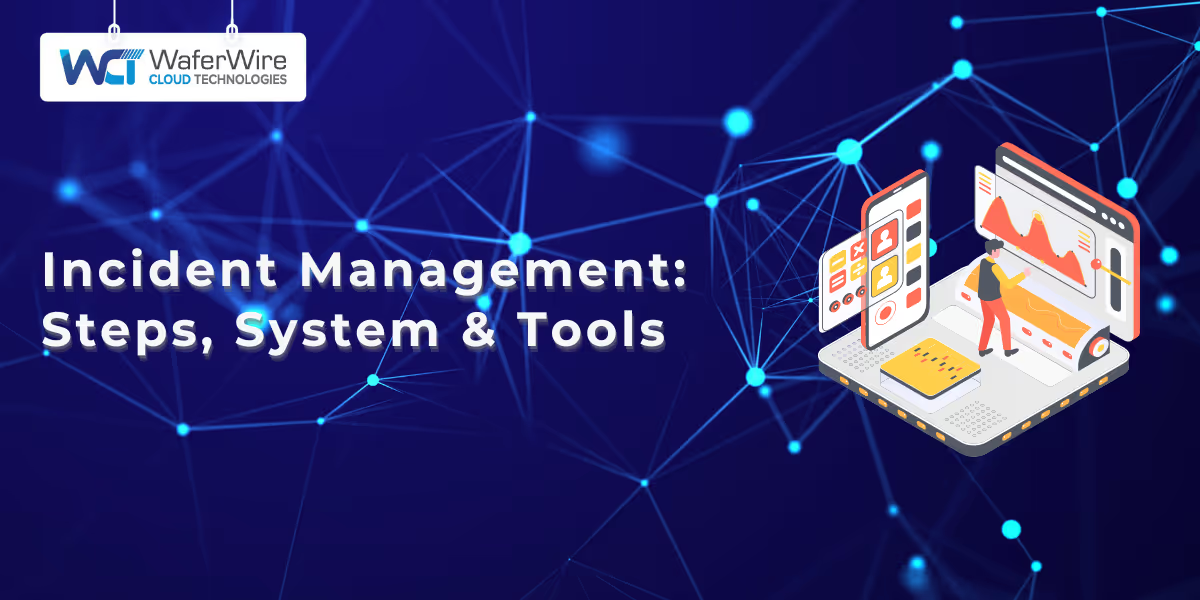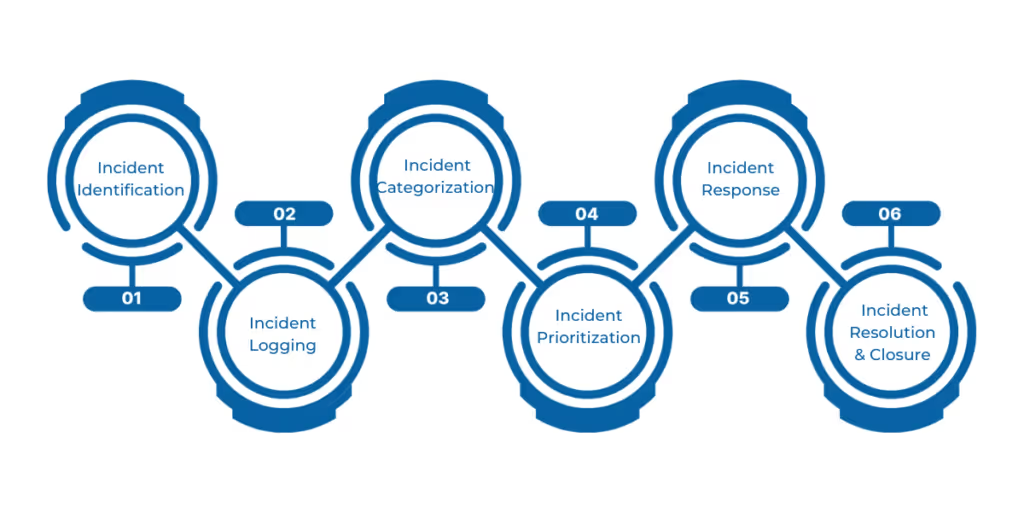

Have you ever encountered a project roadblock that requires your team’s collaboration to regain momentum? The majority of us have experienced it. The bright side is that there is now a methodical way to deal with these interruptions head-on without going overboard with deadlines or productivity. By quickly identifying, evaluating, and resolving project disruptions, a well-defined incident management process keeps your team focused on delivering results and maintaining project momentum.
In this guide, we’ll break down the key steps of the incident management process and share best practices to help you build a strategy that keeps your projects on track, no matter what challenges arise.
Incident management is a systematic approach designed to detect, analyze, and resolve disruptions to business operations. Its primary objective is to restore normal service as quickly as possible while minimizing the impact on business performance. More than just troubleshooting, it’s about maintaining operational stability and ensuring business continuity under pressure.
In highly regulated sectors like financial services, the incident management process is a compliance requirement.
Recent studies indicate that the financial impact of IT downtime has increased significantly in recent years. A 2022 Enterprise Management Associates (EMA) report found that unplanned IT downtime costs organizations an average of $12,900 per minute. Beyond financial losses, frequent disruptions can erode customer trust and damage a company’s reputation.
Limiting the immediate impact of an incident is critical, but preventing recurrence is equally important. Root cause analysis is a key part of the incident management process. Organizations can implement long-term solutions, reducing the risk of future disruptions by identifying the underlying issue—whether it’s a software bug, a misconfiguration, or a security vulnerability.
An effective incident management process relies on a combination of clearly defined procedures, robust systems, and specialized tools.
Understanding the importance of incident management is just the beginning. Next, we’ll walk through the specific steps of the incident management process.

A clear, structured incident management process ensures your team knows exactly what steps to take, reducing confusion, speeding up recovery, and preventing the same issues from happening again. Let’s walk through the essential steps that keep your operations running smoothly even when the unexpected happens.
The first step involves recognizing and identifying the incident. This can be achieved through various methods, such as monitoring systems, user reports, or automated alerts. Assigning unique identifiers, detailed descriptions, and appropriate labels to each incident facilitates accurate tracking and management.
Once identified, incidents must be thoroughly documented. Logging can be performed through multiple channels, including phone calls, emails, or web forms. Comprehensive logs should capture essential details like the reporter’s information, time of occurrence, and a clear issue description.
Organizing incidents into specific categories helps in understanding the areas affected and streamlines the response process. By assigning appropriate categories, teams can analyze trends, identify recurring issues, and implement targeted improvements.
Not all incidents have the same level of impact. Prioritizing incidents based on their urgency and potential business impact ensures that critical issues receive immediate attention while less severe ones are addressed in due course.
This phase involves the actual handling of the incident. Depending on the severity, incidents may be escalated to specialized teams. Clear escalation procedures and defined roles ensure that the right personnel address the issue promptly and effectively.
After resolving the incident, it's essential to confirm that the solution is effective and that normal operations have resumed. Gathering feedback from users ensures satisfaction and provides insights for future improvements. Proper closure also involves updating documentation and communicating the resolution to all stakeholders.
Mastering these steps is just the beginning. Now, let’s examine the essential components that make an incident management system reliable, efficient, and ready to handle any disruption.
An efficient incident management process doesn’t happen by chance. It’s built on a solid foundation where people, processes, and tools work together to detect, respond to, and resolve incidents quickly. Even minor disruptions can snowball into major operational setbacks without these elements in sync.
People are at the core of any effective incident management system. Defined roles and clear responsibilities ensure swift action when disruptions occur. Safety officers, IT support teams, and stakeholders each play a critical role in managing incidents. Safety officers focus on identifying and mitigating risks, while stakeholders ensure resources are allocated effectively and communication is transparent across teams.
In enterprise environments, CXOs and IT leaders must establish clear escalation paths. This structure minimizes delays and confusion and ensures that the right people handle the right tasks at the right time.
A structured process keeps incident management consistent and efficient. It begins with accurate reporting, where incidents are logged with detailed information like time, impact, and potential causes. Next comes the corrective action phase, where teams diagnose and resolve the issue.
However, the process doesn’t end once the problem is fixed. Closure involves reviewing the incident, documenting lessons learned, and implementing changes to prevent similar issues in the future. This ensures that the incident management process evolves, becoming more resilient over time.
The right tools streamline incident management from start to finish. Incident reporting forms standardize the collection of essential details, ensuring nothing is missed. Apps and project management tools, such as ServiceNow, Jira, and PagerDuty, automate alerts, track incident progress, and facilitate communication between teams.
Businesses that excel in managing disruptions don’t just rely on tools; they adopt best practices that streamline response, improve efficiency, and prevent repeat issues.
The faster you detect an issue, the quicker you can act. Proactive monitoring tools and real-time alerts are key to identifying incidents before they escalate. Early detection minimizes the impact and helps resolve issues while they’re still manageable. Integrating automated alerts into your systems ensures that even the smallest disruptions are flagged immediately, giving your team a head start.
Clear, centralized communication is critical when incidents arise. Using a unified platform for updates keeps everyone informed and reduces miscommunication. Tools like Slack or Microsoft Teams, integrated with incident management platforms, allow seamless information sharing.
Automation also plays a significant role. Automating repetitive tasks like logging incidents or escalating issues frees up teams to focus on resolving the problem faster. Automation reduces manual errors and accelerates the overall incident management process.
Your tools are only as good as the people using them. Regular training ensures that every team member knows their role when an incident occurs. This includes understanding how to report incidents, who to escalate to, and how to use the tools effectively.
Consistent training sessions, incident simulations, and refresher courses help teams stay sharp. In industries like finance and utilities, where downtime can have critical consequences, having a well-prepared team makes all the difference.
Incident management doesn’t stop when the issue is resolved. Continuous improvement is key to building long-term resilience. Conduct regular reviews to identify gaps in the process, and optimize workflows to prevent future incidents.
This commitment to refinement ensures that the incident management process evolves with your business. It’s about learning from every big or small incident and making the necessary adjustments to reduce risks over time.
The real value of a post-incident review comes from understanding why it happened and ensuring it doesn’t happen again. This post-incident review checklist is essential for growth, resilience, and continuous improvement.
Post-mortem reviews allow teams to reflect on incidents after resolution. These reviews focus on what went wrong, what went right, and where improvements are needed. It’s not about assigning blame; it’s about uncovering gaps in processes or tools that may have contributed to the issue.
Documenting these insights ensures that both the team and the wider organization benefit from each incident, turning mistakes into valuable learning opportunities.
Simply resolving incidents isn’t enough. Teams must analyze the root causes to prevent recurrence. Root cause analysis helps identify the underlying factors—whether they’re technical failures, misconfigurations, or communication breakdowns.
This proactive approach strengthens the overall incident management process and ensures the same problems don’t disrupt operations repeatedly.
Post-incident insights shouldn’t sit in isolated reports. They need to be integrated into your processes and shared across the organization. Updating your knowledge base with these insights provides teams with reference points for future incidents.
When knowledge is shared, teams respond faster and more efficiently, building a stronger, more resilient organization.
Turning incidents into improvements is key, but the right tools make the process efficient. The following are essential tools for streamlining your incident management process.
The right technology can reduce response times, streamline communication, and ensure incidents are tracked and resolved efficiently.
Incident management software helps detect, log, and manage incidents from start to finish. Platforms like ServiceNow, PagerDuty, and Jira Service Management automate workflows, prioritize incidents, and provide real-time updates to all stakeholders. These tools centralize data, making it easier for teams to access critical information and take swift action.
Clear, timely communication is crucial during incident response. When integrated with incident management platforms, tools like Slack and Microsoft Teams allow teams to collaborate in real time, share updates, and coordinate tasks without delays.
Task management features ensure that responsibilities are clearly assigned and everyone knows their role. This reduces confusion and ensures the incident management process moves forward smoothly, even in high-pressure situations.
Beyond resolving incidents, it’s important to track and analyze data to improve future responses. Tools like Splunk and Datadog provide detailed analytics and visualizations that help teams identify patterns, detect recurring issues, and optimize their incident management process.
Data-driven insights allow organizations to make informed decisions, improve system reliability, and prevent future disruptions. This is especially important for industries like utilities and retail, where system uptime directly impacts revenue and customer satisfaction.
Successful businesses proactively anticipate, address, and learn from challenges instead of merely resolving them. While minimizing downtime is a key aim of a structured incident management process, additional goals encompass maintaining customer trust, safeguarding revenue, and ensuring business continuity.
At WaferWire, we go beyond offering generic solutions. We partner with enterprises like yours to design incident management strategies that respond to disruptions and turn them into growth opportunities. Our experience across industries like finance, retail, manufacturing, and utilities means we understand your unique challenges and know how to overcome them.
Don’t let incidents dictate your success. Take control with a robust, future-ready incident management system. Contact us today and see how we can help your business stay agile, resilient, and always ahead of the curve.

